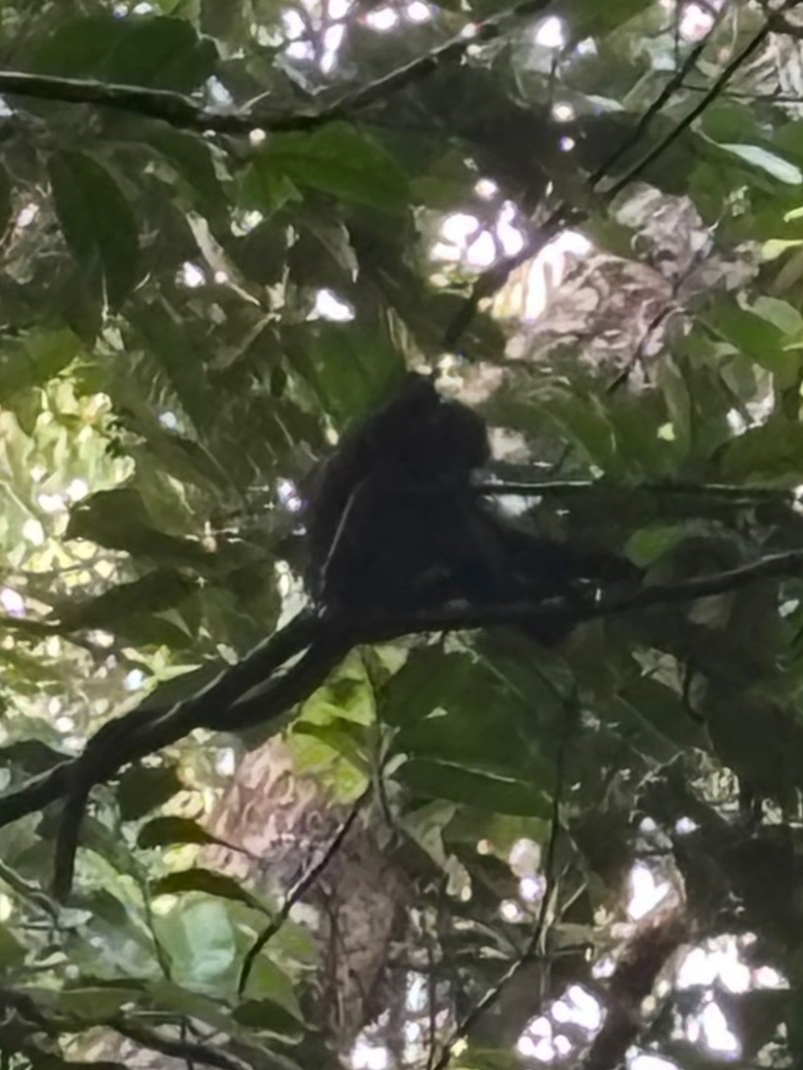Around once a month, I get up early on a weekend morning and head out on a particular mission. I did it again this week, spending three hours in the early morning heat, with my head craned up towards the treetops in. I am looking for monkeys. Not just any monkey, but a very rare breed of monkey, specifically the Raffles’ Banded Langur. Found only in Southern Peninsular Malaysia and Singapore, they are recognized on the list of the World’s Top 25 Most Endangered Primates with a global population of just a few hundred.
My blurry snap of a Raffles Banded Langur, a critically endangered member of the langur group of monkeys.
In Singapore, the population is limited to just 76 individuals (as of 2024). The reason for my monthly exploration is my participation in a long-running Citizen Science Survey, which is just concluding its 16th edition and aims to identify their numbers and better learn their behaviour in Singapore.
I’ve been involved off and on for around five years, and I must have done the same route along Old Upper Thomson Road and through Thomson Nature Park, for the project, or simply for my own pleasure, around 50 times. As a sign of the elusiveness of the langurs, I’ve seen them a grand total of twice. Once was back when I was writing a story on them for a regional travel magazine, and the other was two months ago on one of my most recent survey walks.
The sheer joy I got from spending 20 minutes observing this troop of around 5-6 langurs, playing and feeding as they slowly made their way through the high canopy, is hard to put into words. The group I spotted last time consisted of three adults who were sedately eating leaves, while two juveniles and one even younger langur chased each other through the branches with slightly reckless abandon.
Unlike their distant cousins, the slightly stocky and powerfully built long-tailed macaques which also call Singapore home, the langurs are graceful animals. Covered in a coat of fluffy black fur, which frames their lively, inquisitive faces, their long, rangy limbs and elongated prehensile tails allow them to glide through the treetops with seemingly effortless, balletic speed.
The fact that the troop I got to enjoy had such a surfeit of youngsters is clearly a positive sign that the RBL community in Singapore is still in relatively healthy shape, for now at least. This reality was backed up by a 2023 research paper, which forecast that the local population could even double over the next 15 years.
Raffles Banded Langur (Presbytis femoralis). Photo by Andie Ang.
However, their long-term survival and, in fact, the long-term survival of langurs in general, is potentially less clear. This underlines the continued importance of the surveys which are organized by the Raffles Banded Langur Working Group (RBLWG). Founded in 2016, as a partnership of organisations and agencies in Singapore and Malaysia, their central aim is trying to conserve the species.
On this land-starved island, that means ensuring the continued protection of their natural habitats in and around the Central Catchment Reserve. It also involves understanding the movement of the langurs to try and reduce the threat of animal-human conflicts, especially the danger of being hit by vehicles as they try and cross from one fragment of forest to another.
Habitat loss and humans are not just threatening the long-term survival of Singapore’s Raffles Banded Langurs but are having a devastating impact on populations of all types of langurs in the region. The IUCN Red List identifies that 24 of the 28 types of langurs found in the Sundaland region, a diverse mix of biodiverse habitats that spans Brunei, Indonesia, Malaysia, Myanmar, Singapore, and Thailand, are threatened with extinction.
This desperate situation was the driving force behind the 10-year Asian Langurs Conservation Action Plan. Launched in 2024 at a special conference in Kuching, Malaysia, it is the work of over 30 leading primatology experts in the region, including Singapore’s Andie Ang, who also heads up the Raffles Banded Langur Working Group.
The plan looks to focus on nine main strategies for the protection of these medium-sized, mostly arboreal primates, which range from extensive field studies to truly understand population numbers to improved habitat protection and connectivity. Indeed, connectivity may be crucial as there is a fear that certain populations (including Singapore’s RBLs) may already be in danger of genetic isolation. This is the driver behind arguably the plan's boldest suggestion which recommends relocating populations of each of the 28 langur taxa in at least two relatively large and well-managed protected areas in the region.
You can read more details on the plan’s suggestions, including increased awareness, a focus on conservation tourism, better wildlife legislation, and greater collaboration between projects in this detailed report in the ever-excellent Mongabay.
Raffles Banded Langur on an installed rope bridge. Photo by Sabrina Jabbar.
As well as getting to very occasionally spot langurs in Singapore, I’ve also been fortunate to enjoy encounters with other sub-species, such as the Dusky Leafed or Spectacled Langur in Malaysia and Thailand, during my time in the region. Langurs are beautiful, gentle animals that really deserve our support and protection. The hope is that this plan will ensure more people will get to have their own magical encounters in the years to come.



